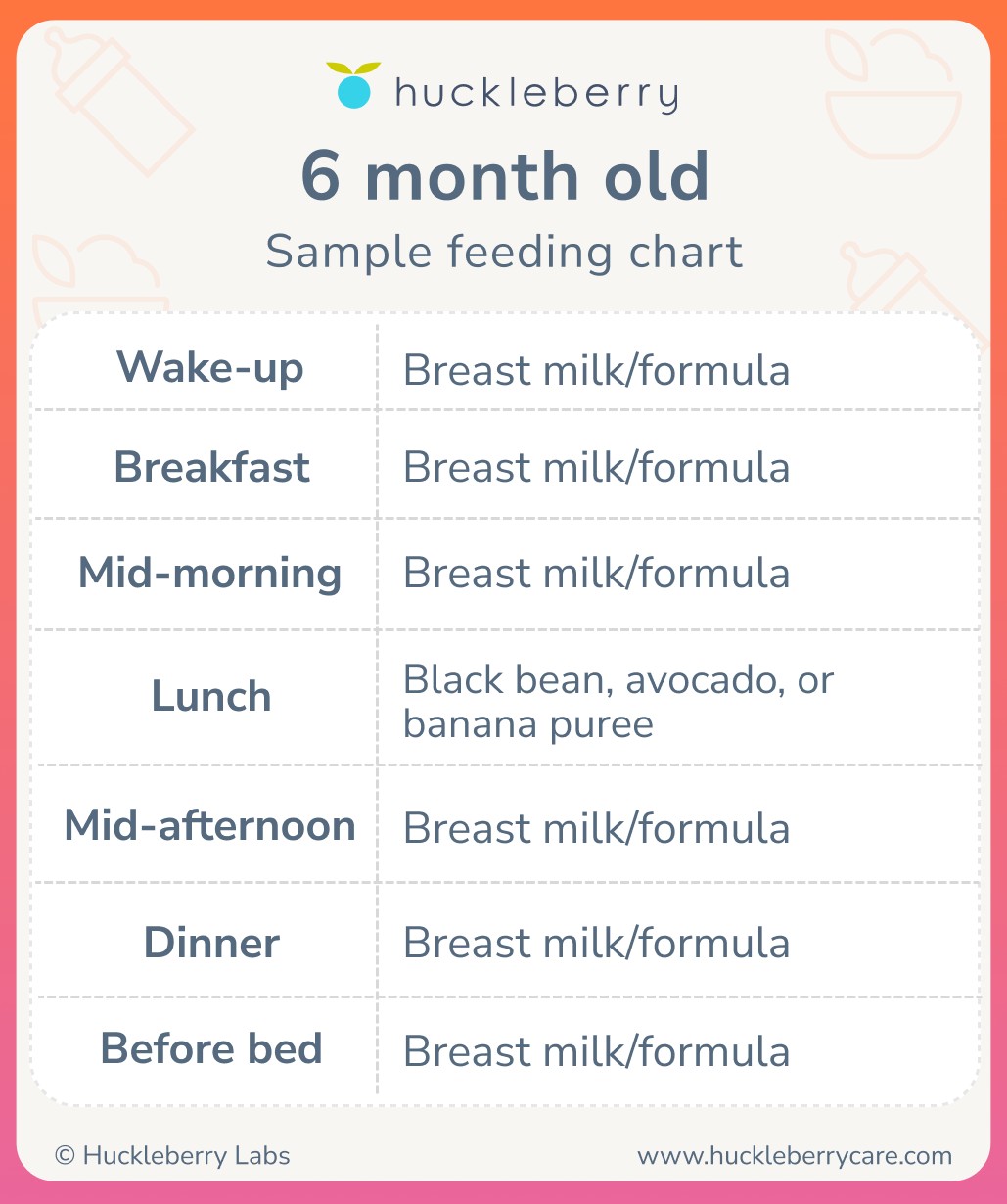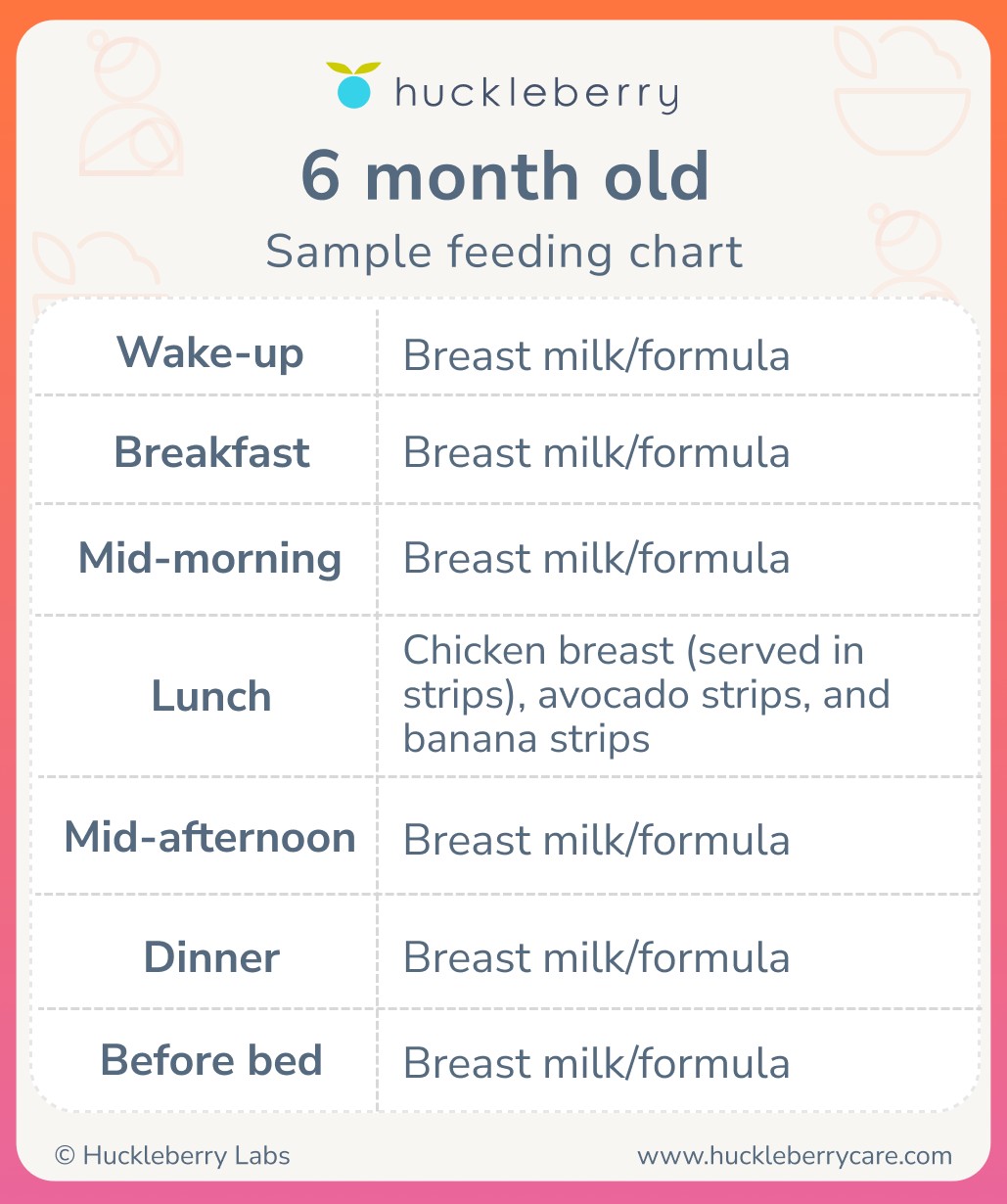Around 6 months, your baby is likely ready to start exploring the world of solid foods. This is an exciting milestone, but it can also bring up a lot of questions, including, “How much should my 6-month-old eat?” While breast milk or formula remains the primary source of nutrition until age 1, introducing solids is an important step. This guide provides everything you need to know about feeding your 6-month-old, including sample schedules and helpful tips.
Sample Feeding Schedule for a 6-Month-Old
Remember that every baby is different, and their schedule will vary based on individual needs and your family’s routines. The following schedule is a sample guide, not a rigid plan. Observe your baby’s cues and adjust as needed.
| Time | Activity |
|---|---|
| 6:30 AM | Nurse or bottle (wake up) |
| 8:00 AM | Solid food meal |
| 10:00 AM | Nurse or bottle |
| 1:30 PM | Nurse or bottle |
| 4:30 PM | Nurse or bottle |
| 6:30/7:00 PM | Nurse or bottle (before bed) |


Food Chart: How Much to Feed a 6-Month-Old
At 6 months, your baby will continue to get most of their nutrition from breast milk and/or formula while gradually exploring solid foods. You can introduce solids in the form of purees or follow a baby-led weaning (BLW) approach.
Most babies will continue to consume approximately 22-28 ounces of breast milk or formula per day, divided into about 4-6 feedings. As long as your baby is growing well and producing 4-6 wet diapers daily, they are likely getting enough to eat. Solid food intake at this age is typically small, around 1-2 tablespoons of purees or a few bites of appropriately sized and textured food for baby-led weaning.
Baby-Led Weaning (BLW) Sample
Baby-led weaning allows babies to self-feed finger foods from the start. Ensure foods are soft and easy to grasp.
| Time | Food |
|---|---|
| Wake-up: | Breast milk or formula |
| Breakfast: | Breast milk or formula |
| Mid-morning: | Breast milk or formula |
| Lunch: | Chicken breast strips, avocado strips, banana strips |
| Mid-afternoon: | Breast milk or formula |
| Dinner: | Breast milk or formula |
| Before bed: | Breast milk or formula |
Purees Sample
Offering purees is another way to introduce solids. You can make your own or buy commercially prepared purees.
| Time | Food |
|---|---|
| Wake-up: | Breast milk or formula |
| Breakfast: | Breast milk or formula |
| Mid-morning: | Breast milk or formula |
| Lunch: | Black bean, avocado, or banana puree |
| Mid-afternoon: | Breast milk or formula |
| Dinner: | Breast milk or formula |
| Before bed: | Breast milk or formula |
7 Tips for Feeding Your 6-Month-Old Baby
- Maintain Liquid Feedings: Breast milk or formula is still your baby’s primary source of nutrition. Don’t reduce these feeds drastically when introducing solids.
- Follow Hunger and Fullness Cues: Pay attention to your baby’s signals, whether they are nursing, bottle-feeding, or eating solids. Feeding patterns may change temporarily if your baby is sick or teething.
- Check for Readiness Signs: Ensure your baby can sit with minimal support, bring objects to their mouth, has good head and neck control, and shows interest in food before starting solids.
- Start Slowly: Babies at this age learn through exploration and play with their food. There’s no need to rush them to eat large quantities of solids. Offer one solid meal per day initially.
- Ensure Safety: Always feed your baby in a supported high chair and never leave them unattended while eating. Serve food in appropriate sizes and consistencies to prevent choking.
- Prioritize Key Nutrients: Focus on foods rich in iron, zinc, protein, and other essential nutrients. These nutrients are crucial for growth and development.
- Introduce Allergens Early and Often: Current research suggests introducing common allergens like peanuts, eggs, and dairy early in life may reduce the risk of developing food allergies. Consult your pediatrician for guidance, but generally, introduce these foods early and often, unless otherwise advised.
Night Feedings for 6-Month-Olds
While many babies can sleep for longer periods at night around this age, it’s common for them to still need 1-2 night feedings. If your baby wakes up hungry, feed them as usual. However, unless your pediatrician advises otherwise, there’s usually no need to wake a baby to feed them.
In Summary: Feeding Your 6-Month-Old
Feeding your 6-month-old is an exciting and sometimes challenging journey. Remember that breast milk and/or formula remain crucial, while your baby explores new tastes and textures. Take it slow, pay attention to your baby’s cues, and enjoy this new phase of feeding.
6-Month-Old Feeding Schedule: FAQs
Q: Can a 6-month-old drink water?
A: Yes, a 6-month-old can start drinking small amounts of water. Offer a few sips with meals from an open cup or straw cup. Avoid giving too much water to prevent it from displacing formula or breast milk.
Q: How often should a 6-month-old eat?
A: Many 6-month-olds eat roughly every 3-4 hours throughout the day. Breastfed babies may eat more frequently. It’s common for babies at this age to wake up to eat 1-2 times a night as well.
Q: How long can a 6-month-old go between feeds?
A: It depends on the baby. Some may go 4-5 hours between feeds, especially with solid meals. Some 6-month-olds may also sleep 7-8 hours at night without needing to eat. Follow your baby’s hunger and fullness cues.
Q: Can you stop night feeds at 6 months?
A: If your baby is getting enough calories during the day and growing well, you might be able to stop night feeds. However, it’s common for them to still need 1-2 night feedings. Talk to your pediatrician to see if dropping night feeds is right for your baby.
Q: Why is my 6-month-old eating less than usual?
A: There could be several reasons: teething, feeling unwell, or simply not being as hungry. As long as they continue to grow, there’s usually no need to worry.
Q: What is a 6-month nursing strike?
A: A nursing strike is when your baby suddenly refuses to breastfeed. This can happen for various reasons, including increased distractibility, teething, a stuffy nose, or an ear infection. Most nursing strikes resolve within 2-4 days.
Q: Is 30 oz too much for a 6-month-old?
A: Every baby’s needs are different. Typically, 6-month-olds eat about 22-28 oz a day, but a little above or below that is usually fine.
Q: Is 4 feeds a day enough for a 6-month-old?
A: Yes, 4 feeds a day may be sufficient if your baby is growing adequately and producing 4-6 wet diapers daily. At this age, many babies eat between 4-6 times a day.